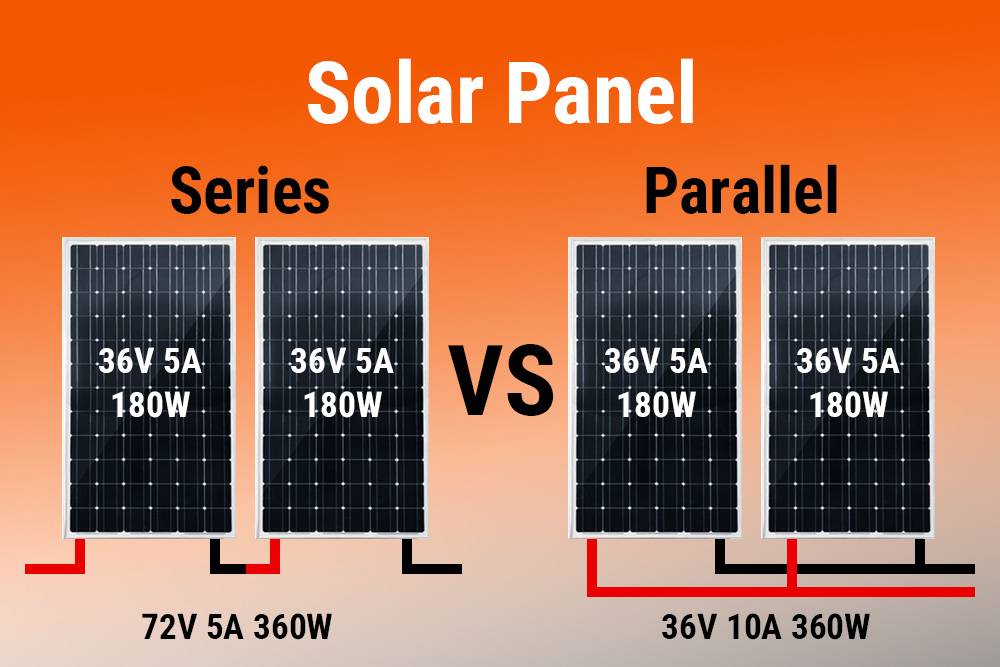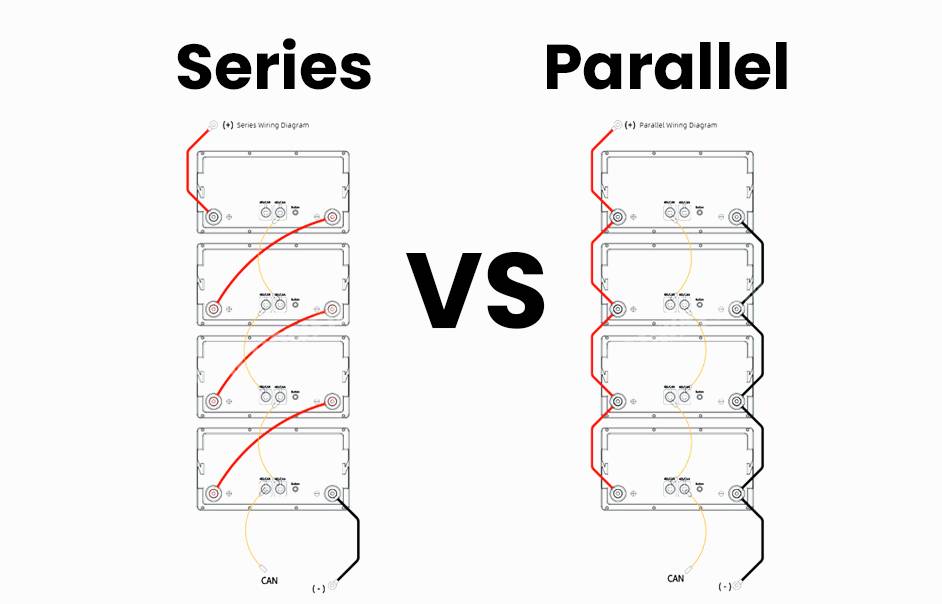In the realm of solar energy systems, understanding how to wire solar panels is crucial for optimizing performance and efficiency. By grasping the principles behind series, parallel, and series-parallel wiring configurations, solar enthusiasts can tailor their systems to meet specific energy needs and environmental conditions. This article delves into the intricacies of solar panel wiring, offering insights into the hows, whys, and whats of different wiring setups.
Also check:
Wiring Batteries in Series vs Parallel, Which is Better?
Should Boat Batteries Be In Parallel?
RV Solar Panels, All You Need to Know
Solar Panel Series vs Parallel: Which is Better?
How Series Wiring Works
In series wiring, solar panels are connected by linking the positive terminal of one panel to the negative terminal of the next. This method increases voltage output while maintaining a consistent amperage. Let’s explore the key aspects of series wiring:
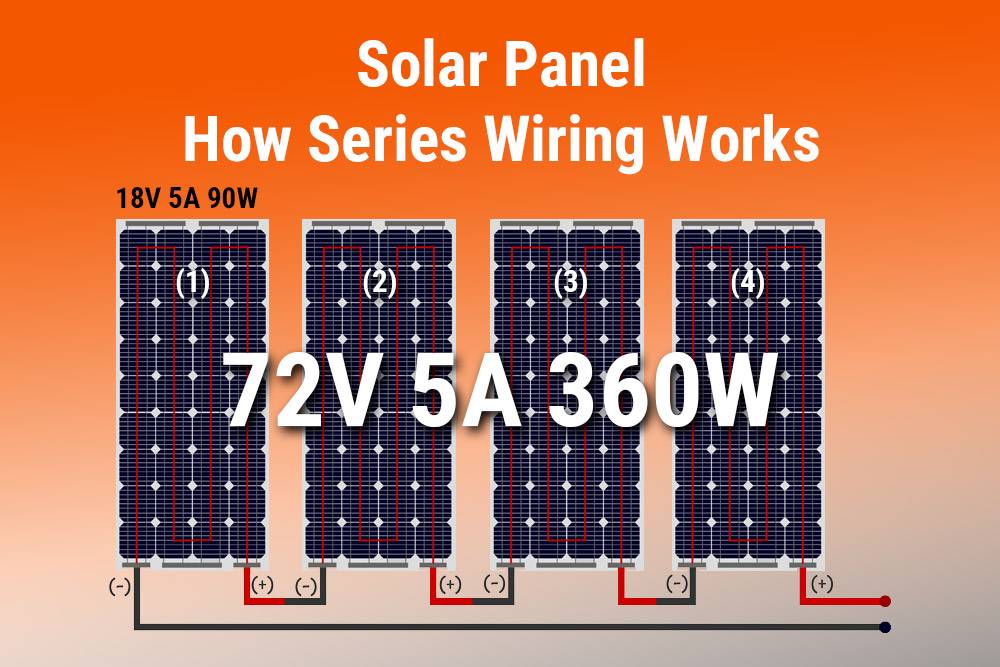
- Wiring Configuration: Connect the positive terminal of one panel to the negative terminal of another to create a continuous string of panels.
- Voltage and Amps: The total voltage output equals the sum of all panel voltages, while the current remains constant, equivalent to the output of a single panel.
- Optimal Conditions and Applications: Series wiring excels in unshaded environments, maximizing power output under consistent sunlight. It’s ideal for low-amperage systems and allows the use of smaller gauge wires, reducing costs and simplifying installation.
In summary, series wiring offers an efficient approach to harnessing solar energy effectively, particularly in unshaded environments and low-amperage systems. By understanding its principles and selecting the appropriate charge controller, solar enthusiasts can maximize the performance and longevity of their energy systems.
Why Parallel Wiring is Used
Parallel wiring connects the positive terminals of multiple solar panels together, as well as the negative terminals. This method increases amperage while maintaining a constant voltage. Let’s delve into the reasons behind using parallel wiring and its practical applications:
- Wiring Configuration: Connect all positive terminals of the panels together, and likewise for the negative terminals, to create a parallel array.
- Voltage and Amperage: While the total current output increases, the voltage remains consistent, equivalent to that of a single panel.
- Optimal Conditions and Uses: Parallel wiring allows panels to function independently, making it ideal for locations with varying light conditions. It’s also suitable for low-voltage systems using PWM controllers, as it enables higher charging currents without affecting voltage levels.
In summary, parallel wiring offers versatility and efficiency in solar panel setups, particularly in environments with fluctuating light levels. By understanding its principles and applications, solar enthusiasts can optimize their energy systems for reliable performance and maximum output.
Solar Panels in Series vs Parallel, Which is Better?
When comparing solar panels wired in series versus parallel, the choice depends on your specific requirements and environmental conditions. Both configurations have their advantages and disadvantages, so it’s essential to consider factors like shading, system voltage, and controller type before deciding which one is better for your situation. Ultimately, the best option is the one that aligns with your goals and maximizes the efficiency of your solar power system. Now, let’s delve into which option—series or parallel—is better suited for your needs.
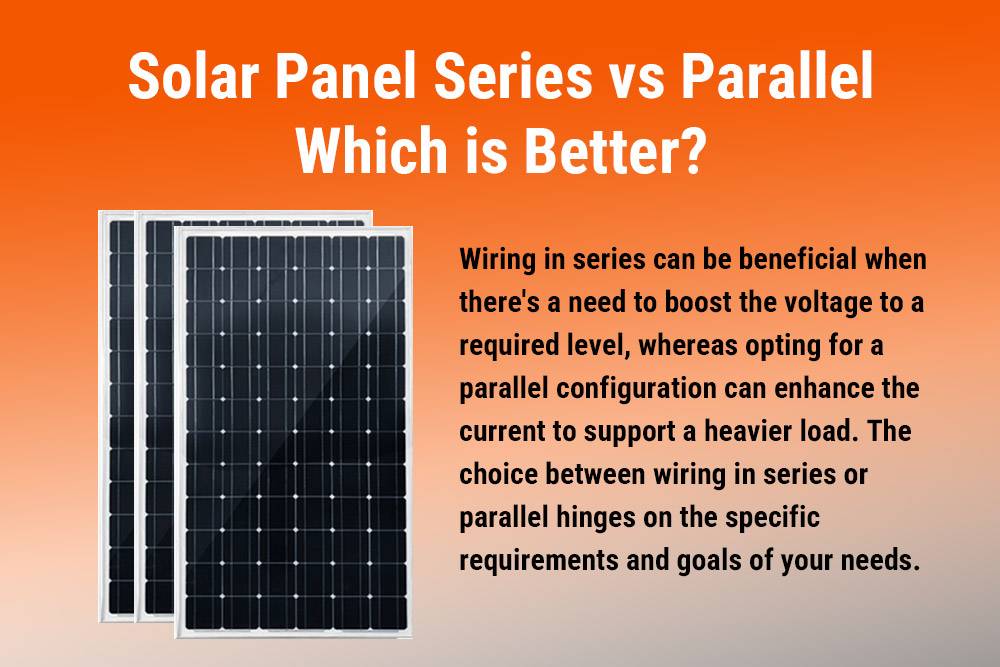
- Series Wiring for Efficiency: If your setup allows for consistent exposure to sunlight without shading, wiring solar panels in series is often preferred. This configuration ensures higher efficiency throughout the day, even during cloudy periods. By harnessing the combined voltage of the panels, series wiring simplifies the charging process for batteries, especially those requiring higher voltages. For instance, lithium batteries typically need 14.4 volts to start charging. With solar panels in series, achieving this voltage is more feasible, as each panel contributes to the total voltage output.
- Parallel Wiring for Flexibility: On the other hand, parallel wiring offers flexibility, making it suitable for applications with variable lighting conditions or smaller setups like RVs or boats. While parallel setups may not achieve the same level of efficiency as series wiring, they are cost-effective, particularly when paired with lower-cost PWM charge controllers. This option is practical for systems where the focus is on maintaining consistent power output under varying environmental conditions.
Understanding Series-Parallel Wiring
Understanding how to wire solar panels in series or parallel is crucial for optimizing the performance of your solar array. Let’s delve into the intricacies of series-parallel setups and explore their benefits and guidelines for mixing panel types.
- Mixing Panel Types in Series or Parallel: When combining solar panels from different manufacturers or with varying specifications, it’s crucial to adhere to specific guidelines.
- Series Configuration Guidelines: In a series setup, ensure that all panels possess identical current ratings. While voltages add up, the system’s current output aligns with the lowest-rated panel in the series.
- Parallel Configuration Guidelines: In parallel wiring, all panels should share the same voltage rating. The system output voltage matches the panel with the lowest voltage rating.
- Optimizing Panel Mix: It’s generally best to use identical panels within each array on a charge controller. Alternatively, utilizing multiple charge controllers, each assigned to a separate panel array, can maximize solar output.
- Choosing the Best Option: The decision to wire solar panels in series or parallel hinges on individual needs and application requirements. Both options offer distinct benefits and drawbacks, emphasizing the importance of aligning with specific system goals.
In summary, the choice between series and parallel wiring for solar panels is nuanced and should be tailored to meet specific objectives. For personalized guidance on selecting the optimal wiring configuration, feel free to reach out to us at HERE.
What Factors Influence Configuration Choice
- System Size: The size of the solar power system plays a significant role in determining whether to wire panels in series or parallel. Larger systems may benefit from series-parallel configurations for optimal performance and scalability.
- Voltage Requirements: Understanding the voltage requirements of the system is crucial. Series wiring increases voltage, making it suitable for systems that require higher voltage output. Meanwhile, parallel wiring increases current, which may be preferable for systems with lower voltage requirements.
- Shading Concerns: Shading issues can impact the efficiency of solar panels. Series wiring can be more susceptible to power loss from shading, whereas parallel wiring allows panels to operate independently, making it better suited for locations prone to shading.
These factors should be carefully considered to determine the most appropriate configuration for maximizing the effectiveness of the solar power system.
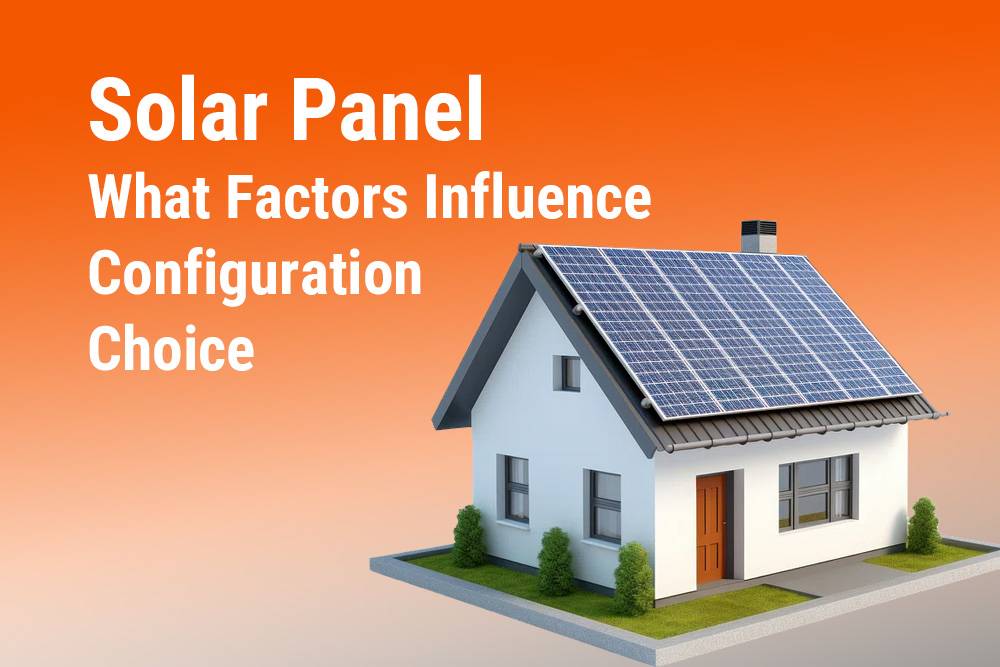
How to Expand and Upgrade Systems
Expanding or upgrading a solar power system requires careful planning and consideration of various factors. Here’s a simplified guide to help you navigate the process effectively:
- Assess Current Setup: Start by evaluating your existing solar system, including the number of panels, batteries, and other components. Understand your current energy needs and identify areas for improvement.
- Identify Expansion Goals: Determine why you want to expand or upgrade your system. Whether it’s to accommodate increased energy demands, improve efficiency, or integrate new technologies, clarifying your goals will guide your decision-making process.
- Calculate Additional Requirements: Calculate the additional capacity needed to meet your expanded energy requirements. Consider factors like peak power demand, average daily consumption, and future growth potential to size your system correctly.
- Select Compatible Components: Choose new components that are compatible with your existing system, including solar panels, batteries, inverters, and charge controllers. Ensure compatibility in terms of voltage, capacity, and communication protocols.
- Plan Wiring and Installation: Plan the wiring and installation of new components carefully. Consider factors like wire gauge, cable lengths, and proper grounding to ensure safe and efficient operation.
- Install New Components: Install the new components according to manufacturer guidelines and industry best practices. Pay attention to proper mounting, wiring, and connection to maximize performance and safety.
- Test and Verify: Test the expanded system to ensure everything is functioning correctly. Verify that all components are working as intended and that the system meets your energy needs.
- Monitor and Maintain: Regularly monitor the performance of your expanded solar system and perform routine maintenance as needed. Address any issues promptly to ensure optimal operation and longevity.
Expanding and upgrading your solar power system can enhance its performance and efficiency, allowing you to meet your energy needs more effectively while reducing reliance on the grid. By following these steps, you can navigate the process smoothly and enjoy the benefits of a more robust solar setup.
FAQs
What are the main differences between series and parallel wiring for solar panels?
Series wiring increases voltage output but maintains the same current, while parallel wiring increases current output but maintains the same voltage. Series connections are suitable for higher voltage requirements, while parallel connections are better for increasing current.
Which wiring configuration is more resistant to shading effects?
Parallel wiring is more resistant to shading effects because each panel operates independently. In series wiring, shading on one panel can significantly reduce the output of the entire string.
What factors should I consider when deciding between series and parallel wiring?
Consider your system size, voltage requirements, shading concerns, and the type of charge controller you’ll be using. Larger systems may benefit from series-parallel configurations, while smaller systems may suffice with either series or parallel wiring.
Does wiring solar panels in series or parallel affect the type of charge controller needed?
Yes, the wiring configuration can affect the choice of charge controller. MPPT (Maximum Power Point Tracking) controllers are more suitable for series wiring, while PWM (Pulse Width Modulation) controllers work well with parallel wiring.
Can I mix different types of solar panels in a series or parallel configuration?
Yes, but it’s essential to follow specific guidelines. In series wiring, panels should have the same current rating, while in parallel wiring, panels should have the same voltage rating. Mixing panel types may require multiple charge controllers to optimize performance.
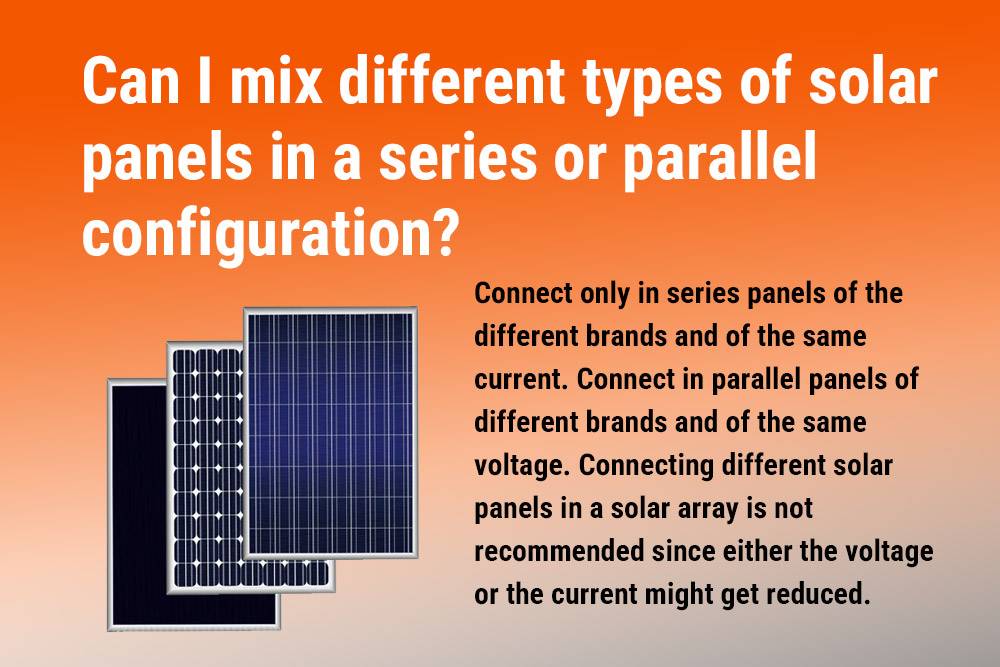
Which configuration is more cost-effective for my solar power system?
The cost-effectiveness depends on various factors, including your specific requirements and environmental conditions. Series wiring may require fewer cables and smaller gauge wires, potentially reducing installation costs. However, parallel wiring may be more suitable for systems with shading concerns, potentially increasing long-term efficiency and performance.

